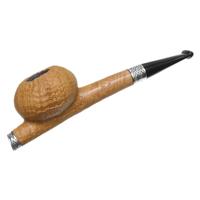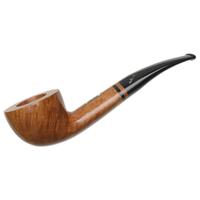OK, Cosmic, you asked for it! Here you go....!!!
THE PURCHASE
I bought these via an online auction that was based in Adelaide, Australia, which is on the southern coast. They were displayed in an old-time museum-style display case with a typewritten label identifying them as something like the World's Finest Briar pipes from Tilshead, England, or some such thing. My suspicion is that they had been on display at the Buring Tobacconists, where a portion of the Buring pipe collection had been on display. In the 1950s, it had been thought to be the 2nd largest pipe collection in the world. Obviously, these pipes were made much later, but I also bought some very historic items as part of that auction.
Since the pipes had been held in clips around the shanks in the glass-doored case, I was concerned that the briar may have darkened unevenly. Some woods are very photosensitive, like cherry, and darken in sunlight. They reported back that there was no sign of that sort of issue, but that there were "light scratches" from the metal clips. I figured that I could buff those out. By the way, the auctioneer confirmed that they were all unsmoked.
I won the auction, paying less than my maximum, but a bit more than I'd hoped. As it turned out, according to Frank Burla, a few other items I bought at that auction have turned out to be quite valuable and I paid a bare pittance. I only wish I'd had the knowledge fo bid on a few other historic items, like the vintage embroidered smoking caps which sold for peanuts. However, I'd already spent as much as I was comfortable spending.
SHIPPING
What a nightmare. The auctioneer recommended a local Pack and Send, which is much like a US-based UPS Store. They are independently-owned franchises. I gave careful instructions for removing the pipes from the clips to avoid further scratching and asked that he send the pipes as economically as possible. Suffice it to say that it took weeks for him to pack and ship the pipes, with many broken promises along the way. By the end of this period, we weren't exactly best buds. He claimed it took a lot of time to carefully pack nearly 40 pipes, plus the cabinet. Give me a break. Well, he did. The cabinet arrived packed separately from the pipes, in a box that was clearly inadequate to protect the glass door, which was shattered. I'm convinced that this was the shipping version of the waiter spitting in your food. Of course, the owner didn't actually buy the insurance that I'd paid for and didn't submit the claim on my behalf as he had promised to do. Eventually, Pack and Send stepped in and I received enough to cover the shipping and the loss of the cabinet. The glass was installed in a way which made it essentially impossible to replace.
THE PIPES
Well, the pipes were everything I'd hoped. Beautiful, unsmoked, early- to mid-1980s James Upshall high grades, many with Les Wood silver work. Upon closer inspection, I saw that the "light scratches" were actually fairly deep cuts and scratches in both the shanks and some of the silver mounts. The idiots who built the cabinet used stamped steel conduit clips which have sharp wire-edges which tightly grip the steel conduit it's designed to hold. In addition, they smelled like books that had been stored in the back corner of the cellar for years and years. I'd hoped that with a little sunshine, time, and a few smokes, the musty aromas would just go away. Ha!!!
During this period, I posted a photo of the pipes and the cabinet here in one of the forums and one of the founders of James Upshall, Ken Barnes, commented on them and provided me great information on when they were made, the source of the briar, and even the name of the Greek man who dug them up. We have continued to correspond since. He's a real gentleman and someone that I'd like to meet in person someday.
THE SCRATCHES
I tried buffing to start. Nary a dent. Then I tried steaming the cuts, followed by buffing. This was markedly better, but the cuts were still awfully obvious. Ken Barnes suggested that I use a burnishing rod on them, followed by some dark carnauba wax. As it happened, I already have a burnishing rod for sharpening steel card scrapers, which are an alternative to sandpaper for smoothing wood. It's a very hard and highly-polished elliptical rod with a wooden handle. Rubbing this firmly over the scratches all but erased the smaller scratches. The larger ones were visible, but not obtrusive to me, and I'm pretty picky.
THE AROMA
Wow. What a trial this part has been. Who'd have thought that the aroma could be so hard to get rid of. What I've discovered is that it permeated not only the briar, but also the vulcanite stems. I tried:
- Sunlight
- Low heat
- Baking soda
- Activated Charcoal
- Ozone cabinet treatment
- Baking them in a sous-vide, which is a temperature-controlled water bath
- Salt and Alcohol treatment
- Retort
- Soaking in quaternary sanitizer, such as is used for disinfecting dishes in a commercial kitchen or in a brewery
- Complete submersion in alcohol
- Lightly sanding the inside of the bowl on a couple of the pipes.
- Time
- Packing the pipe with unwanted old, dried- out Burley
- Smoking the pipe
None of these made much of a dent in the aroma. Furthermore, the musty aroma was also evident in my mouth -- especially after I was done smoking. Blech!
Finally, I tried putting the stummels in a cast iron Dutch oven with a bare UV sanitizing lamp with the lid ajar, to allow heat to escape. These lights create not only UV, but a bit of heat and also ozone. Even though I'd separately treated the pipes with each of those elements previously, this time, it seemed to work. The pipes I'd already smoked were more resistant, but most of the unsmoked pipes are now odor-free. A few may need a second round of UV treatment, but I suspect they'll be fine.
THE END RESULT
In the end, I've decided to keep all the pipes. Originally, I'd planned to sell my least favorite 12 pipes in hopes of paying for the other 12. Given what I paid, this was certainly plausible. However, in view of the diminished resale value due to scratches on some (but not all) of the pipes, my own reluctance to sell a pipe that might still have a musty flavor that my nose can't detect, plus the fact that they're just damned beautiful, great smokers with a story behind them, I've decided to keep and enjoy them all. It will take quite awhile for me to get around to smoking all of them. In fact, some may remain unsmoked.















 :
: